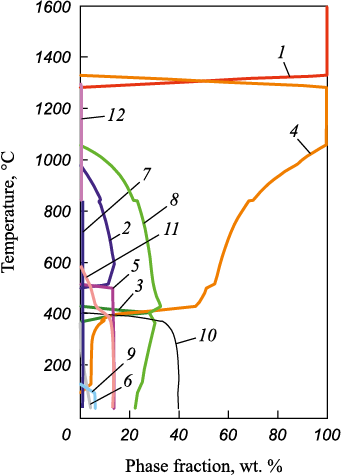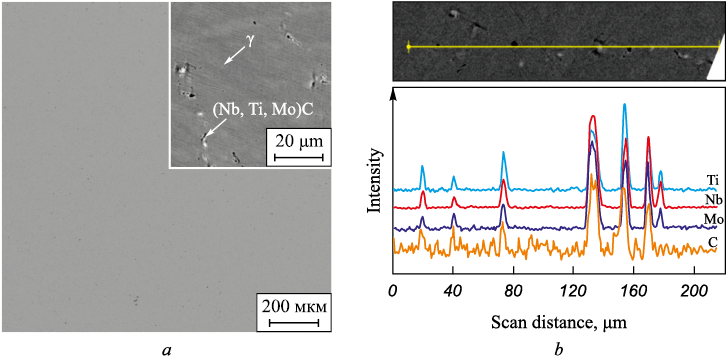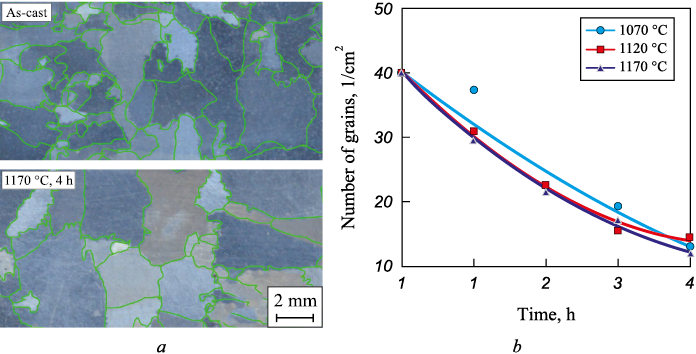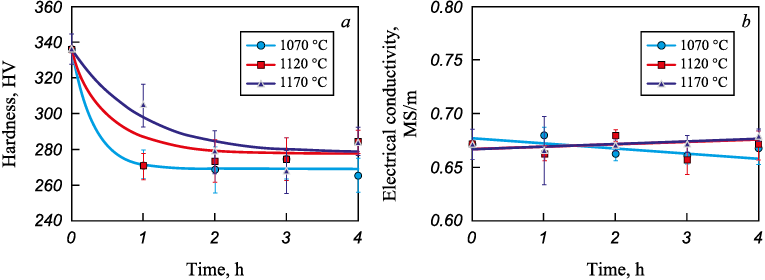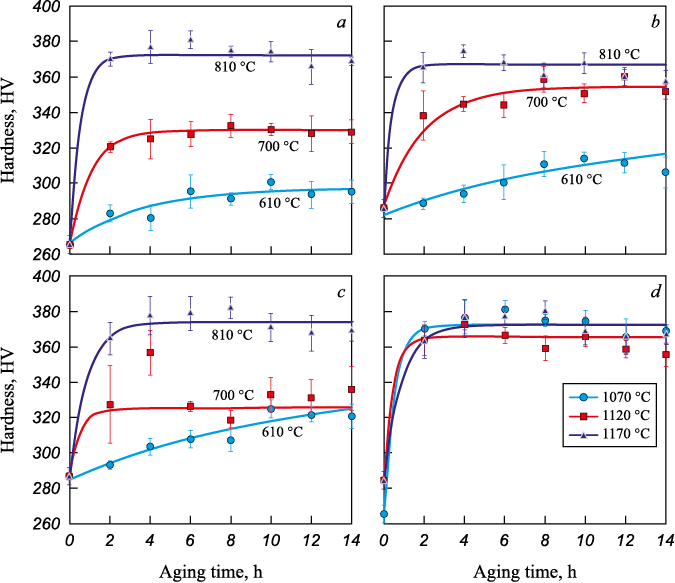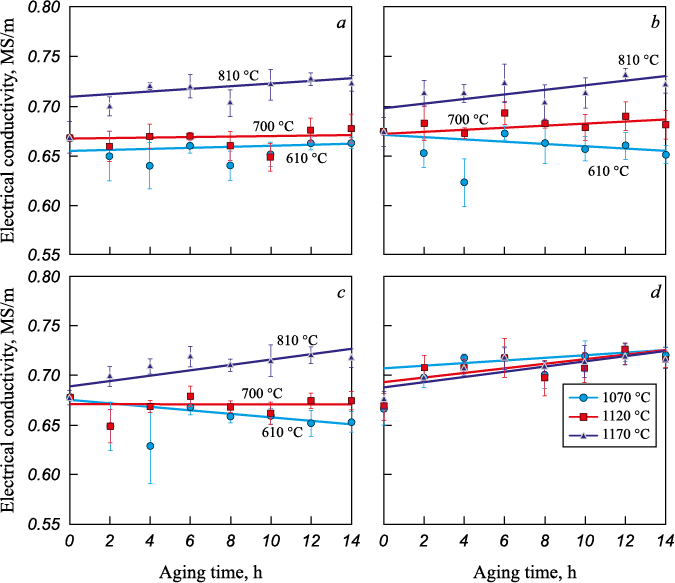Scroll to:
Influence of heat treatment on structure, phase composition, hardness and electrical conductivity of VZhL14N-VI nickel superalloy
https://doi.org/10.17073/0368-0797-2025-1-60-68
Abstract
The phase composition of VZhL14N-VI nickel superalloy was analyzed in a wide temperature range – from room temperature to 1600 °C by means of CALPHAD (CALculation of PHAse Diagrams) calculations. In light of the findings, the authors devised potential heat treatment modes for VZhL14N-VI superalloy. The impact of different heat treatment modes on the grain size, hardness, and electrical conductivity of VZhL14N-VI superalloy samples produced by ceramic mold casting was investigated, as well as the effect on the alloy of high-temperature annealing at 1070 – 1170 ℃ for 1 – 4 h. The alloy heat treatment resulted in a notable increase in grain size and a decrease in hardness. The influence of artificial aging temperature after high-temperature annealing and quenching on the hardness and electrical conductivity of the alloy in the range of 610 – 810 ℃ was studied. At 810 °C, the alloy exhibits the most pronounced aging effect, accompanied by a rapid increase in hardness, reaching approximately 370 HV. In contrast to the observed changes in hardness, the electrical conductivity of the alloy exhibited minimal variation during the aging process. The proposed heat treatment conditions diverge from those recommended by the OST 1 90126–85 Russian standard for this alloy. The developed heat treatment mode includes the alloy heat treatment at a temperature of 1170 ± 10 ℃ for 4 h, followed by air cooling and aging at a temperature of 810 ± 10 ℃ for 10 – 14 h, followed by air cooling. The proposed heat treatment mode is expected to result in an increase in hardness of VZhL14N-VI superalloy castings by 10 – 20 HV in comparison to the samples subjected to the standard heat treatment mode.
For citations:
Koltygin A.V., Bazhenov V.E., Belova A.A., Sannikov A.V., Lyskovich A.A., Belov V.D., Shchedrin E.Yu. Influence of heat treatment on structure, phase composition, hardness and electrical conductivity of VZhL14N-VI nickel superalloy. Izvestiya. Ferrous Metallurgy. 2025;68(1):60-68. https://doi.org/10.17073/0368-0797-2025-1-60-68
Introduction
Currently, a wide range of nickel-based heat-resistant cast superalloys have been developed and successfully applied for the production of heat-resistant structural components in aircraft engines [1; 2]. In Russian aircraft engineering, VZhL14N-VI alloy (OST 1 90126–85; base – Ni; up to 0.08 % C1; up to 20.0 % Cr; up to 5.0 % Mo; up to 1.5 % Al; up to 2.9 % Ti; up to 2.8 % Nb; up to 10 % Fe) is widely used for large-scale structural castings, particularly in combustion chamber components. This alloy primarily contains chromium and iron as major alloying elements and has no direct foreign equivalents. The closest in composition are Inconel 718 (ASTM Ni B670) and Inconel 718Plus (UNS N07818) alloys. These belong to the second generation of superalloys, characterized by a high chromium content, often with cobalt, as well as refractory elements such as tungsten, molybdenum, and niobium. A key feature of these alloys is their substantial γ′ phase content (a face-centered cubic ordered Ni3(Al, Ti) phase) [1; 3; 4]. The primary requirement for combustion chamber structural components, which operate at moderate temperatures of 500 – 900 °C and pressures up to 45 atm, is high strength combined with good ductility across the entire temperature range [5]. This is achieved through the complex alloying of the Fe – Ni alloy with solid-solution strengthening and carbide-forming elements. Chromium is a component of the Ni-based solid solution, contributing to its strengthening, while also being involved in carbide formation. This significantly enhances the oxidation resistance of the Ni – Fe alloy at operating temperatures [4 – 6]. Aluminum and titanium promote the formation of the γ′ phase and strengthen the alloy during heat treatment. Molybdenum, tungsten, and niobium are added as carbide-forming elements responsible for the formation of fine-dispersed carbides, which enhance the alloy’s high-temperature strength. They also strengthen the solid solution, while niobium, in addition, participates in the formation of strengthening precipitates in the nickel-based solid solution slightly reducing the processability of the alloy by impairing the weldability and machinability of castings [7; 8]. The addition of iron reduces the overall cost of the alloy due to the lower cost of iron compared to nickel, replacing part of the nickel content. At a moderate iron content, as in VZhL14N-VI alloy, its long-term strength at the operating temperatures of combustion chamber components remains at an acceptable level.
The operational properties of VZhL14N-VI alloy castings are strongly influenced by the quantity of alloying elements, the carbide and strengthening phases they form, and their distribution within the alloy structure. While the impact of individual alloying elements and structural components on the operational properties of VZhL14N-VI alloy has been well studied [1 – 5], the effect of structure and phase composition formation conditions on the mechanical properties of castings remains insufficiently explored. This often results in deviations of the alloy’s properties from expected values [9; 10]. It is crucial to consider both the formation of the as-cast structure and the structure obtained after heat treatment [1; 10; 11]. The operational properties of cast components are determined by the combination of grain size and metal structure. The hardening of VZhL14N-VI-type alloys is primarily governed by the formation of γ′ strengthening precipitates within the γ matrix phase. These precipitates exhibit greater thermal stability compared to γ″ (a body-centered tetragonal ordered Ni3Nb phase), which forms in other heat-resistant nickel alloys. Additionally, the hardening of the alloy is influenced by the precipitation of δ (orthorhombic Ni3Nb), η (hexagonal Ni3Ti), and σ (hexagonal CrFeMoNi, CrMoNi, (Cr, Mo)3Ni) phases, along with carbide phases such as MeC, Me23C6 , and Me6C (Me7C3 is rarely observed). These phases have a face-centered cubic lattice and limit grain growth in the alloy [11 – 14]. By adjusting the heat treatment modes to control the formation of these phases, the mechanical properties of cast components can be modified within a relatively broad range.
This study examines the effect of heat treatment modes on the macro- and microstructure, phase composition, and hardness of VZhL14N-VI alloy samples produced by ceramic mold casting to determine their influence on alloy hardening.
Materials and methods
The test samples were cut from cast plates measuring 100×100×10 mm. The castings were produced using ceramic mold casting technology. Fused quartz of various fractions, manufactured by DINUR (Pervouralsk, Russia), was used as the filler for the slurry and stucco coating. To prepare the refractory slurry, Ultracast One+ and Ultracast Prime binders (Technopark LLC, Moscow, Russia) were used. Pre-alloyed VZhL14N-VI, produced by VIAM (Moscow, Russia), was used as the charge material. The melting and pouring of the alloy were performed in a vacuum induction melting and casting unit (VAKETO, Moscow, Russia) using a mullite-corundum-zirconium crucible manufactured by ELEMET (Elektrogorsk, Russia). From the obtained castings, samples measuring 4×9×56 mm were cut. The alloy samples were subjected to heat treatment in a muffle furnace in air at temperatures of 1070, 1120, and 1170 °C. The duration of high-temperature treatment ranged from 1 to 4 h, with 1 h increments. The samples were quenched by air blow cooling. For aging, samples quenched after 4 h of high-temperature soaking were used. The aging process was studied under three heat treatment modes, involving soaking at 610, 700, and 810 ± 10 °C for 2 to 14 h.
The microstructure of the alloy was examined using a TESCAN VEGA 3 SBH scanning electron microscope (SEM) equipped with an Oxford energy-dispersive microanalysis system and a Carl Zeiss Axio Observer D1m optical microscope. To reveal the grain structure, metallographic samples were etched using Marble’s reagent (20 g Cu2SO4 , 100 mL hydrochloric acid, 100 mL ethanol) [15]. To examine the microstructure, an acid mixture (30 mL nitric acid, 0.5 mL hydrochloric acid, 70 mL acetic acid) was also used for etching [16]. The phases present in the microstructure were identified using energy-dispersive X-ray spectroscopy (EDS), based on literature data concerning possible compounds in heat-resistant nickel-based alloys [14; 17] and phase composition calculations.
The electrical conductivity of the alloys was measured using a non-contact eddy current conductometer VE-27NC3 (SIGMA, Russia), with a measurement range of 0.5–2.5 MS/m.
Vickers hardness (HV 10) was determined using a NEMESIS 9001 universal hardness tester (INNOVATEST) under a 10 kgf load, with a loading time of 12 s.
The equilibrium phase composition of VZhL14N-VI alloy in the temperature range of 20 to 1600 °C was calculated using the Thermo-Calc software with the TCS Ni-based Superalloys Database (TCNI8).
Results and discussion
To achieve a more precise phase identification, the phase composition of the VZhL14N-VI alloy was calculated in the temperature range of 20 to 1600 °C using Thermo-Calc software. The results of the equilibrium phase composition calculation, based on the average composition of VZhL14N-VI alloy in accordance with OST 1 90126–85, are presented in Fig. 1.
Fig. 1. Calculated phase composition of VZhL14N-VI superalloy |
It can be observed that from the equilibrium solidus temperature (approximately 1280 °C) down to 1050 °C, the alloy is almost single-phase, consisting primarily of the γ phase. Below 1050 °C, the main strengthening phase for this alloy, γ′, begins to precipitate [18]. At approximately 980 °C, the σ phase starts to form, which is commonly observed in heat-resistant nickel-based alloys containing iron and typically appears as irregularly shaped globules. With a further decrease in temperature, the volume fractions of γ′ and σ phases gradually increase. At approximately 850 °C, carbide inclusions of Me23C6 start to appear in the structure, where Me is primarily chromium, along with iron and molybdenum. At 600 °C, the equilibrium content of γ′ and σ phases reaches its maximum. When the temperature drops below 600 °C, unwanted particles with a chromium-based solid solution lattice begin to appear in the equilibrium structure. Below 500 °C, the σ phase completely disappears, and other undesirable phases emerge in the structure. Additionally, the equilibrium volume fractions of γ and γ′ phases decrease significantly below 400 °C. Thus, within the operating temperature range of combustion chamber cast components in aircraft gas turbine engines made from VZhL14N-VI alloy (750 – 950 °C) [19], the equilibrium phase composition consists of the γ phase, with dispersed γ′ and σ phase particles, where the γ′ phase predominates. Additionally, a small number of carbide particles are present in the structure, primarily Me23C6 carbides, with occasional occurrences of MeC carbides.
The as-cast structure of VZhL14N-VI alloy, produced by ceramic mold casting, is shown in Fig. 2, a. The microstructure consists of a nickel-based solid solution matrix (γ phase) with finely dispersed carbide precipitates containing niobium, titanium, and a significant amount of molybdenum, in addition to carbon (Fig. 2, b). According to the calculated phase composition of the alloy (Fig. 1), these carbides begin to precipitate directly from the liquid phase. During heat treatment at temperatures below 850 °C, they are expected to transform into Me23C6-type carbides.
Fig. 2. Microstructure of VZhL14N-VI superalloy obtained by ceramic mold casting (a) |
Fig. 3 presents the microstructure of VZhL14N-VI alloy after heat treatment following the mode specified in OST 1 90126–85 for this alloy. The treatment includes annealing at 1120 ± 10 °C for 3 h, followed by air cooling, and aging at 700 ± 10 °C for 16 h, with subsequent air cooling.
Fig. 3. Микроструктура сплава ВЖЛ14Н-ВИ после термической обработки |
As seen in Fig. 3, a, heat treatment led to a reduction in dendritic segregation of elements, although complete chemical homogenization was not achieved. Despite thermodynamic calculations predicting that niobium and titanium carbides should dissolve during high-temperature annealing and be replaced by ultrafine chromium-based Me23C6 carbide precipitates during aging, niobium and titanium carbides were still observed in the alloy structure after heat treatment. Additionally, some carbide particles exhibited increased nitrogen content, which most likely inhibits their dissolution.
It is well known that, according to the Hall–Petch effect, the grain size of polycrystalline nickel-based alloy castings significantly affects their mechanical properties [20]. The influence of various high-temperature heat treatment modes on grain size was studied. Fig. 4, a shows the grain structure of samples solidified under identical cooling conditions in the as-cast state and after heat treatment. Grain coarsening occurs during annealing. Fig. 4, b illustrates the effect of high-temperature heat treatment duration on the grain density on the polished sample surface. During 4 h of annealing, the number of grains per 1 cm2 in the metallographic section decreased by approximately 2.6 times, regardless of the annealing temperature. Thus, high-temperature annealing significantly increases the grain size of the alloy, which is a negative factor that reduces the mechanical properties of cast components. Therefore, excessive annealing time is undesirable. Changing the annealing temperature within the studied range (1070 – 1170 °C) had virtually no effect on the grain size of the alloy (Fig. 4, b).
Fig. 4. Grain structure of VZhL14N-VI superalloy in as-cast condition |
Fig. 5 presents the effect of heat treatment on the hardness and electrical conductivity of VZhL14N-VI alloy samples. The temperature of high-temperature annealing within the examined range had a negligible effect on hardness (Fig. 5, a) after quenching. During high-temperature annealing, the hardness of the alloy rapidly decreased from 336 to ~280 HV for all temperatures used. The influence of high-temperature annealing on the electrical conductivity of the alloy was even smaller (Fig. 5, b). It can be assumed that the electrical conductivity of the alloy remains unchanged during annealing. However, it should be noted that the electrical conductivity measurement method used in this study is relatively crude. Given the small variations in measured electrical conductivity values observed for VZhL14N-VI alloy, the measurement error is relatively high. It is possible that more precise measurement techniques could detect changes in electrical conductivity.
Fig. 5. Influence of temperature and time of holding during high-temperature annealing on hardness (a) |
The temperature and duration of artificial aging had a much stronger effect on alloy hardness than the annealing temperature prior to quenching (Fig. 6). The most significant increase in hardness was observed at the maximum aging temperature of 810 °C. At this temperature, the hardness of the alloy reached its near-maximum value of approximately 370 HV within just 2 h of aging. Lower aging temperatures did not result in such significant hardening. The lowest hardness values were observed at 610 °C, where the hardness of the alloy continued to increase throughout the aging process, indicating incomplete decomposition of the supersaturated solid solution. It is evident that this temperature is insufficient for achieving maximum strength through artificial aging. An intermediate hardness level was obtained after aging at 700 °C. The maximum hardening effect, achieved at 810 °C, was practically independent of the annealing temperature before quenching (Fig. 6, d), showing consistent results.
Fig. 6. Influence of high-temperature annealing at 1070 (a), 1120 (b), 1170 ℃ (c) |
The degree of supersaturated γ-phase decomposition can be indirectly assessed based on changes in electrical conductivity [19]. For the VZhL14N-VI alloy, a weak dependence of electrical conductivity on aging temperature and duration was observed (Fig. 7). However, while the electrical conductivity of samples aged at 610 and 700 °C was nearly identical, at 810 °C, a significant difference exceeding the measurement uncertainty interval was detected. The electrical conductivity of samples aged at 810 °C was higher than that of samples aged at 610 and 700 °C. This suggests that at 810 °C, γ phase decomposition occurs at a higher rate. At the same time, the electrical conductivity of alloys subjected to high-temperature annealing for solid solution treatment at different temperatures varies insignificantly during aging (Fig. 7, d).
Fig. 7. Influence of high-temperature annealing at 1070 (a), 1120 (b), 1170 ℃ (c) |
Thus, the highest hardening effect was achieved in VZhL14N-VI alloy samples that were annealed at 1170 °C for 4 h and then artificially aged at 810 °C for 10 – 14 h. The proposed heat treatment mode differs slightly from the current standard specified in OST 1 90126–85 and results in a small hardness increase of 10 – 20 HV in VZhL14N-VI alloy. This mode may be of interest for heat treatment of cast components operating at temperatures above 800 °C.
Conclusions
The as-cast grain structure of VZhL14N-VI alloy primarily consists of a γ phase solid solution with (Nb, Ti, Mo)C carbide inclusions.
During heat treatment, which includes high-temperature solution annealing followed by artificial aging, a noticeable reduction in coring of alloying elements within the γ phase solid solution is observed. However, the morphology of niobium and molybdenum carbides, identified through X-ray microanalysis, remains unchanged.
Thermodynamic calculations have shown that aging at temperatures below 600 °C may lead to the formation of undesirable phases in the alloy structure, while aging above 850 °C results in a reduction in the volume fraction of hardening γ′ and σ particles and inhibits the precipitation of Me23C6-type carbides.
It has been established that the highest hardening effect is observed in alloys aged at 810 °C, ensuring the most complete decomposition of the supersaturated γ phase solid solution. At the same time, within the studied range of 1070 – 1170 °C, the solution annealing temperature has a significantly smaller effect on the hardening of the alloy compared to the aging temperature. The maximum hardness during aging is reached within 4 – 6 h and remains practically unchanged up to 10 – 14 h.
References
1. Logunov A.V., Shmotin Yu.N. Modern Nickel Superalloys for Gas Turbine Disks (Materials and Technologies). Moscow: Nauka i tekhnologii. 2013:264. (In. Russ.).
2. Sun B., Wang J., Shu D. Precision Forming Technology of Large Superalloy Castings for Aircraft Engines. Singapore: Springer Singapore; 2021:409. https://doi.org/10.1007/978-981-33-6220-8
3. Hassan B., Corney J. Grain boundary precipitation in Inconel 718 and ATI 718Plus. Materials Science and Technology. 2017;33(16):1879–89. https://doi.org/10.1080/02670836.2017.1333222
4. Cemal M., Cevik S., Uzunonat Y., Diltemiz F. ALLVAC 718 Plus™ Superalloy for Aircraft Engine Applications. In: Recent Advances in Aircraft Technology. 2012:75–96. https://doi.org/10.5772/38433
5. Kablov E.N. History of Aviation Materials Science: VIAM – 75 Years of Search, Creativity, Discoveries. Moscow: Nauka, 2007:343. (In. Russ.).
6. Lu J., Yang Z., Li Y., Huang J., Zhao X., Yuan Y. Effect of alloying chemistry on fireside corrosion behavior of Ni–Fe-based superalloy for ultra-supercritical boiler applications. Oxidation of Metals. 2018;89(5–6):609–621. https://doi.org/10.1007/s11085-017-9804-7
7. Dolgopolov V.G. Study of the structure and effect of heat treatment on the mechanical properties of nickel-base alloys. Innovative Processes in Research and Educational Activities. 2014;1:60–62.
8. Logunov A.V. Problems of Design and Production of High-Temperature Cast Blades for Aircraft Gas Turbine Engines. Vol. 1: Modeling and Digitalization. Moscow: Nauka i tekhnologii; 2023:469. (In. Russ.).
9. Oborin L.A., Babitskiy N.A., Zhereb V.P. The thermal transformations of foundry high-temperature oxidation-resistant steels during the melting and the crystallization. Journal of Siberian Federal University. Engineering & Technologies. 2012;5(7):724–730. (In. Russ.).
10. Gadalov V.N., Vornacheva I.V., Pankov D.N., Bugorsky I.A., Zagidullin R.R., Sabitov L.S., Ivanov A.A. Study of the influence of the structure of heat-resistant nickel-chrome alloys on their mechanical properties. Izvestiya Tula State University. Technical Science. 2022;(10):463–471.
11. Kirchmayer A., Pröbstle M., Huenert D., Neumeier S., Göken M. Influence of grain size and volume fraction of η/δ precipitates on the dwell fatigue crack propagation rate and creep resistance of the nickel-base superalloy ATI 718Plus. Metallurgical and Materials Transactions A. 2023;54: 2219–2226. https://doi.org/10.1007/s11661-023-07001-3
12. Donachie M.J., Donachie S.J. Superalloys: A Technical Guide. 2nd ed. Materials Park, Ohio: ASM International; 2002:408.
13. Chen Y.T., Yeh A.C., Li M.Y., Kuo S.M. Effects of processing routes on room temperature tensile strength and elongation for Inconel 718. Materials & Design. 2017;119: 235–243. https://doi.org/10.1016/j.matdes.2017.01.069
14. Geddes B., Leon H., Huang X. Superalloys: Alloying and Performance. Materials Park, Ohio: ASM International; 2010:176.
15. Beckert M., Klemm H. Handbuch der metallographischen Ätzverfahren. Leipzig: Deutscher Verlag für Grundstoffindustrie, VEB; 1976:410. (In Germ.).
16. Kovalenko V.S. Metallographic Reagents: Reference Book. 3rd ed. Moscow: Metallurgiya; 1981:120. (In. Russ.).
17. Reed R.C. The Superalloys: Fundamentals and Applications. Cambridge: Cambridge University Press; 2006:372.
18. Logunov A.V. Nickel Superalloys for Blades and Disks of Gas Turbines. Rybinsk: Gazoturbinnye tekhnologii; 2017:854. (In. Russ.).
19. Lefebvre A. Gas Turbine Combustion. Hemisphere Publishing Corporation; 1983:531.
20. Lv J. Effect of grain size on mechanical property and corrosion resistance of the Ni-based alloy 690. Journal of Materials Science & Technology; 2018;34(9):1685–1691. https://doi.org/10.1016/j.jmst.2017.12.017
About the Authors
A. V. KoltyginRussian Federation
Andrei V. Koltygin, Cand. Sci. (Eng.), Assist. Prof. of the Chair “Foundry Technology and Art Processing of Materials”
4 Leninskii Ave., Moscow 119049, Russian Federation
V. E. Bazhenov
Russian Federation
Vyacheslav E. Bazhenov, Cand. Sci. (Eng.), Assist. Prof. of the Chair “Foundry Technology and Art Processing of Materials”
4 Leninskii Ave., Moscow 119049, Russian Federation
A. A. Belova
Russian Federation
Anastasiya A. Belova, Postgraduate of the Chair “Foundry Technology and Art Processing of Materials”
4 Leninskii Ave., Moscow 119049, Russian Federation
A. V. Sannikov
Russian Federation
Andrei V. Sannikov, Cand. Sci. (Eng.), Junior Researcher of the Chair “Foundry Technology and Art Processing of Materials”
4 Leninskii Ave., Moscow 119049, Russian Federation
A. A. Lyskovich
Russian Federation
Anastasiya A. Lyskovich, Postgraduate of the Chair “Foundry Technology and Art Processing of Materials”
4 Leninskii Ave., Moscow 119049, Russian Federation
V. D. Belov
Russian Federation
Vladimir D. Belov, Dr. Sci. (Eng.), Prof., Head of the Chair “Foundry Technology and Art Processing of Materials”
4 Leninskii Ave., Moscow 119049, Russian Federation
E. Yu. Shchedrin
Russian Federation
Evgenii Yu. Shchedrin, Chief Metallurgist
29 Zavodskoe Route, Samara 443009, Russian Federation
Review
For citations:
Koltygin A.V., Bazhenov V.E., Belova A.A., Sannikov A.V., Lyskovich A.A., Belov V.D., Shchedrin E.Yu. Influence of heat treatment on structure, phase composition, hardness and electrical conductivity of VZhL14N-VI nickel superalloy. Izvestiya. Ferrous Metallurgy. 2025;68(1):60-68. https://doi.org/10.17073/0368-0797-2025-1-60-68



